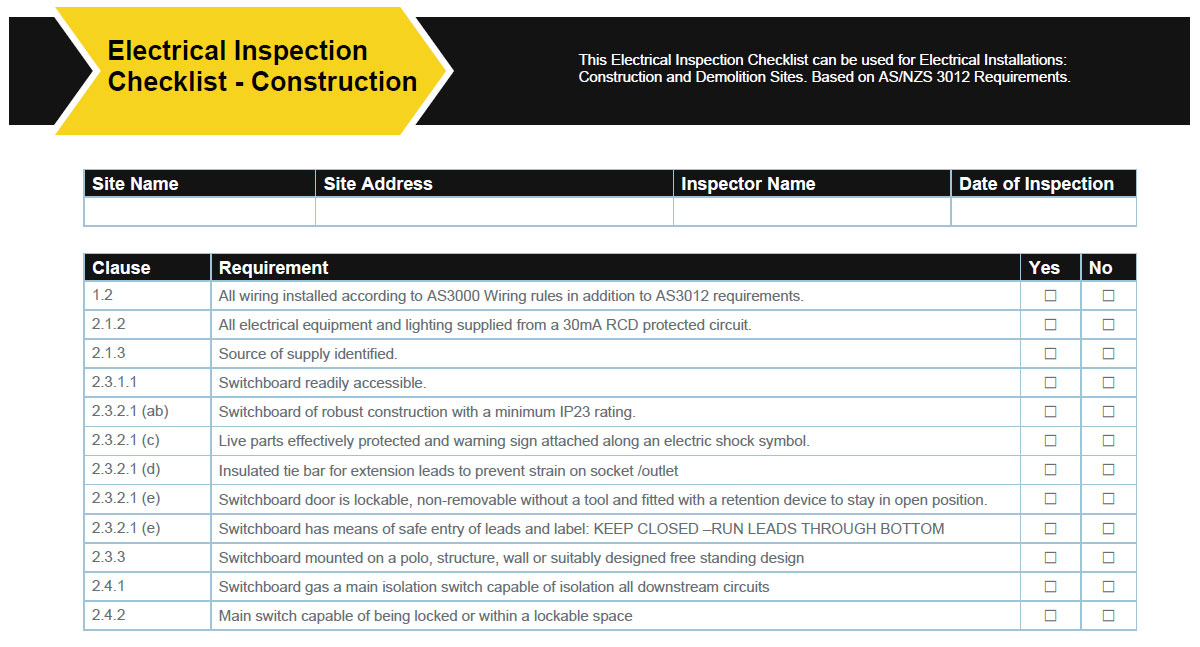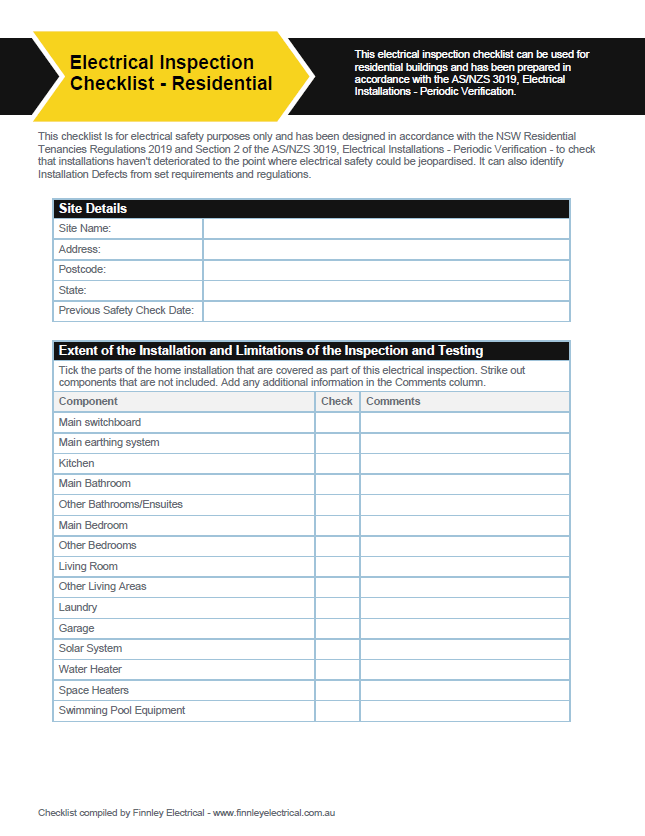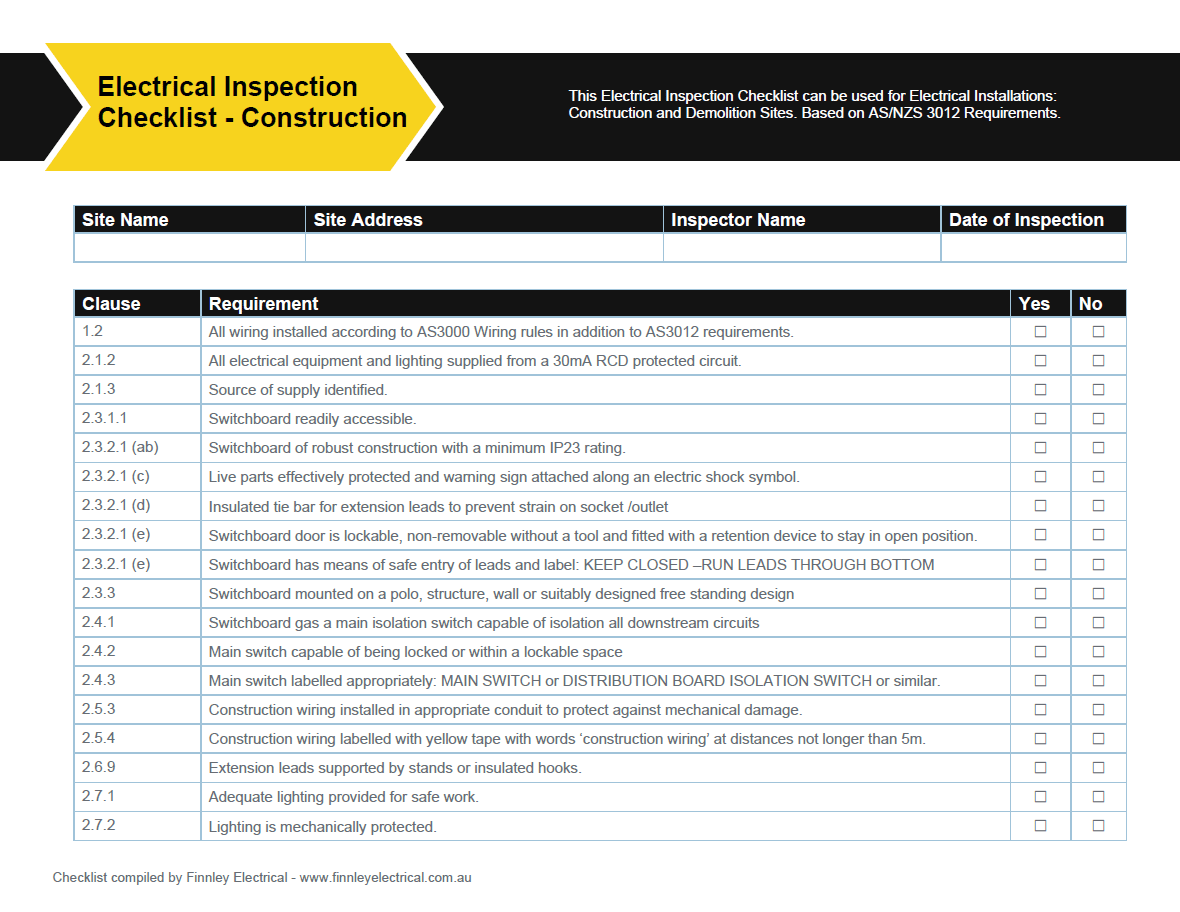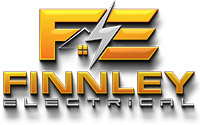An electrician will use an electrical inspection checklist to identify potential electrical hazards in a home or business. When performing an electrical inspection, the checklist helps ensure that all electrical appliances and systems are safe and up to Australian safety standards. At the end of this page, we’ve included two free checklists for you, one for residential homes and one for construction and demolition sites.
What is Electrical Safety Checklist?
An electrical safety checklist is used to identify potential electrical hazards in a home or business. The checklist helps ensure that all electrical appliances and systems are safe and up to code. Electrical safety checklists will generally include checks for:
- Electrical outlets
- Light fixtures
- Switches
- Circuit breakers
- Grounding
- Wiring
- Electrical panel
If you find any electrical hazards, the electrician will make the necessary repairs or replacements.
What should be included in the inspection checklist?
The following items should be included in an electrical inspection checklist:
- Consumer mains (single phase, three phase)
- Switchboards
- Fuses
- Exposed earth electrode
- Metallic water pipe bond
- RCDs / Safety switches
- Circuit protection
- Sockets
- Light fittings
- Electric water heaters
- Space heaters
- Cooking equipment
- Dishwasher
- Exhaust fans
- Ceiling fans
- Washing machine
- Clothes dryer
- Installation wiring
- Solar systems
- Swimming pool equipment
- Electric vehicle chargers
Some of the potential hazards that an electrician will look for include:
- Faulty or damaged electrical wiring
- Poorly installed or maintained electrical appliances and systems
- Exposed live wires
- Inadequate or missing safety switches
- Loose connections
- overloaded power points and circuits.
How to pass electrical inspection
In order to pass an electrical inspection, the property should have no serious defects which could cause fire, shock and/or personal injury. If detected during the inspection, any such defects should be disconnected by the electrician performing the inspection and reported to the relevant electrical authorities.
Minor defects that will not cause fire, shock or personal injury might be detected and recorded on the report but won’t prevent the inspection from passing. These minor defects should be recorded and remediated by a licensed electrician as soon as possible.
It is the responsibility of the property owner to ensure that all electrical appliances and systems are safe and up to Australian safety standards. An electrician can help you ensure that your property passes inspection and is safe for occupancy.
As per the requirements of Regulation 62 of the Electricity Licensing Regulations 1991, ‘where it appears to an electrical worker that there is a defect in any electrical installation or electrical equipment that renders the electrical installation or electrical equipment unsafe, the electrical worker shall immediately report the matter to the owner or operator of the installation, to the relevant supply authority and to the Director’.
AS/NSZ 3019:2007 Electrical Installations – Periodic Verification
Within Australia, when understanding the need for electrical inspections, it is important to consider the requirements of AS/NSZ 3019:2007 Electrical Installation – Periodic Verification. This Standard was prepared by the Joint Standards Australia/Standards New Zealand Committee EL001 Wiring Rules. The Standard provides those who carry out periodic verification a means to reasonably determine whether an installation and all its equipment is safe for continued use and that the electrical installation meets safety requirements to prevent fire and protect persons and livestock from electric shock.
AS/NZS 3019 can be applied by meeting electrical safety requirements that are set by the government in each state of Australia and New Zealand. These requirements necessitate certain electrical installations to be inspected and tested periodically. Furthermore, an electrical installation may be verified upon request by the owner/occupier or another organisation.
This Standard differs from the previous New Zealand-only edition, NZS 3019:2004, in that three levels of verification are specified: by basic visual inspection, by visual inspection and limited testing, and by visual inspection and full testing, rather than the verification of specific types of installations. The verification of caravans and pleasure craft that were previously covered will be in AS/NZS 3001 and AS/NZS 3004 Part 2.
Residential Electrical Inspection Checklist Template for Australia
This Residential Electrical Inspection Checklist template is designed for use at any home or residence within Australia. It has been prepared in accordance with Section 2 of the AS/NSZ 3019, Electrical Installations – Periodic verification standard. You can download the checklist in pdf format.




